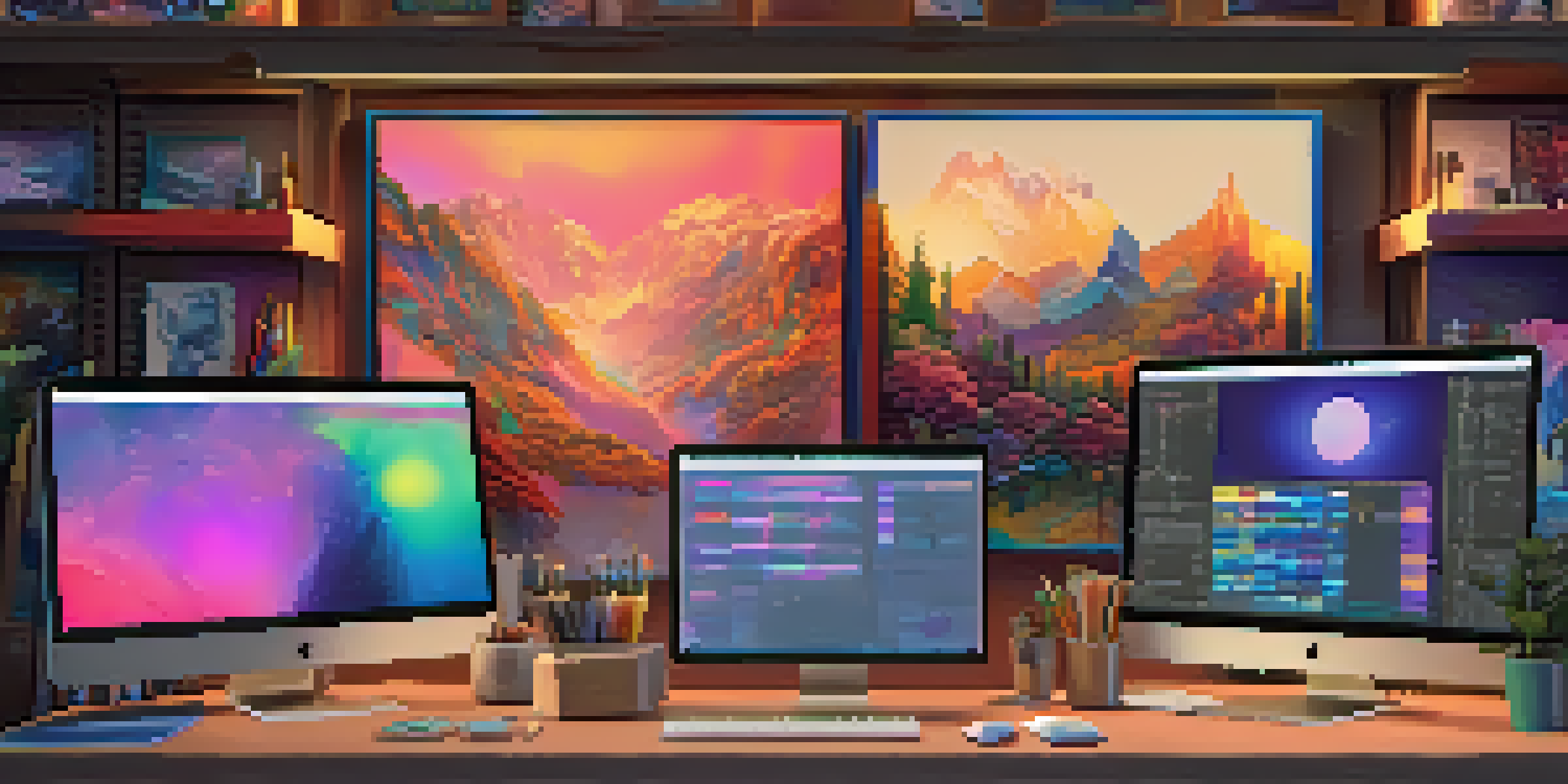The Role of NFTs in Protecting Intellectual Property Rights

Introduction to NFTs and Intellectual Property Rights
Non-fungible tokens, or NFTs, have taken the digital world by storm. They represent unique digital assets that can be owned and traded, often linked to artwork, music, and other forms of intellectual property. Intellectual property rights (IPR) protect creators' works from unauthorized use, and with the rise of NFTs, there's a new tool to help enforce these rights.
Intellectual property is the oil of the 21st century.
NFTs provide a way to prove ownership and authenticity, which is crucial in a world where digital content can be easily copied. Imagine having a certificate of authenticity for your favorite piece of art; that's what NFTs offer to digital creators. By embedding ownership details into the blockchain, NFTs make it easier to track and protect intellectual property.
As we explore the role of NFTs in safeguarding IPR, it’s essential to understand both the opportunities they present and the challenges that come with them. This journey into the intersection of technology and creativity reveals how NFTs could reshape the landscape of intellectual property.
How NFTs Verify Ownership of Digital Assets
One of the standout features of NFTs is their ability to verify ownership. Each NFT is unique and contains specific information about its creator and the asset it represents. This uniqueness is what distinguishes NFTs from traditional digital files, which can be duplicated endlessly without any proof of original ownership.

For example, when an artist creates a digital painting and mints it as an NFT, they can include metadata that links back to their identity and the artwork's history. This process not only establishes their claim to the piece but also allows buyers to verify its authenticity. It's akin to having a title deed for a house; it clearly outlines who owns what.
NFTs Enhance Ownership Verification
NFTs provide a unique way to prove ownership and authenticity of digital assets, crucial in protecting creators' rights.
This verification is crucial in creative industries where plagiarism and unauthorized use are rampant. By providing a clear record of ownership, NFTs can help protect the rights of artists and creators, giving them more control over how their work is used and monetized.
NFTs and Copyright Protection: A New Frontier
Copyright law traditionally protects creators from unauthorized use of their work, but enforcing these rights can be challenging in the digital realm. NFTs introduce a new layer of protection by linking ownership directly to the blockchain, making it easier to trace and enforce copyright claims. This could be a game changer for artists, musicians, and writers who often struggle with copyright infringement.
The future is already here — it's just not very evenly distributed.
When an NFT is created, it can include specific terms regarding the use of the intellectual property it represents. This way, creators can dictate how their work is shared, modified, or sold. It’s like setting the rules for a game before it begins, ensuring that everyone knows what is and isn’t allowed.
However, while NFTs bolster copyright protection, they don’t eliminate the need for traditional copyright registration. Creators should still consider registering their work with relevant authorities to ensure comprehensive protection. The combination of NFTs and traditional copyright can provide a robust framework for safeguarding intellectual property.
Challenges of Using NFTs for Intellectual Property Rights
Despite their potential, NFTs also pose several challenges in protecting intellectual property rights. One major concern is the lack of regulation in the NFT space, which can lead to disputes over ownership and copyright infringement. Since the technology is still relatively new, many legal frameworks have yet to catch up.
Another challenge is the risk of counterfeit NFTs. Just as traditional art can be counterfeited, so too can NFTs. If someone were to mint an NFT of a copyrighted work without the creator's permission, it could create confusion and dilute the original artist's rights. This issue highlights the importance of due diligence when buying or selling NFTs.
Smart Contracts Empower Creators
Smart contracts allow artists to set specific terms for the use of their work, providing greater control over their intellectual property.
Lastly, the environmental impact of blockchain technology, particularly proof-of-work systems, raises ethical questions about the sustainability of NFTs. As creators and consumers navigate these challenges, it’s crucial to approach the NFT landscape with caution and awareness.
The Role of Smart Contracts in NFTs and IPR
Smart contracts play a pivotal role in the functionality of NFTs, particularly in relation to intellectual property rights. These self-executing contracts contain the terms of the agreement directly written into code, allowing for automated execution when conditions are met. This means that artists can include specific licensing terms within the NFT itself.
For instance, an artist might create an NFT that allows the buyer to use the artwork for personal purposes but prohibits commercial use. If someone tries to sell merchandise featuring that artwork without permission, the smart contract can automatically enforce the restrictions. It’s like having a digital gatekeeper that ensures the creator's wishes are honored.
By using smart contracts, creators can have greater control over their intellectual property, enabling them to receive royalties every time their NFT is resold. This continuous revenue stream is a revolutionary shift for artists and creators who often rely on one-time sales. The marriage of NFTs and smart contracts could redefine how intellectual property is monetized.
NFT Marketplaces and Their Impact on IPR Protection
NFT marketplaces serve as the primary platforms for buying and selling NFTs, but they also play a crucial role in intellectual property rights protection. Reputable marketplaces often have measures in place to verify the authenticity of NFTs being sold, which can help reduce the risk of counterfeiting and copyright infringement. This vetting process is essential for maintaining trust in the NFT ecosystem.
For example, some platforms require creators to prove ownership of the original work before they can mint an NFT. This means that buyers can feel more confident that they are purchasing legitimate assets. It’s similar to buying a luxury handbag from an authorized retailer versus a street vendor; one offers assurance of authenticity, while the other is fraught with risk.
Regulation Challenges in NFT Space
The lack of regulation in the NFT market poses risks of ownership disputes and counterfeit assets, highlighting the need for robust guidelines.
However, not all marketplaces enforce these standards equally. Some may allow anyone to mint and sell NFTs without proper verification, which can lead to legal complications for both creators and buyers. As the NFT market continues to evolve, establishing robust guidelines and best practices will be vital for protecting intellectual property rights.
The Future of NFTs in Intellectual Property Rights Protection
Looking ahead, the future of NFTs in protecting intellectual property rights appears promising yet uncertain. As technology advances and awareness grows, more creators are likely to embrace NFTs as a way to safeguard their work. This shift could empower artists and innovators, giving them more control over their intellectual property and how it’s used.
However, for NFTs to reach their full potential in IPR protection, regulatory frameworks must evolve alongside the technology. This includes clarifying the legal standing of NFTs, establishing standards for marketplaces, and creating guidelines to address disputes. It's a collective effort that involves creators, platforms, and policymakers working together.

In conclusion, while NFTs present exciting opportunities for intellectual property protection, they also require careful consideration of the challenges and complexities involved. The journey toward a more secure and equitable digital landscape is just beginning, and the role of NFTs will undoubtedly be a significant part of that evolution.